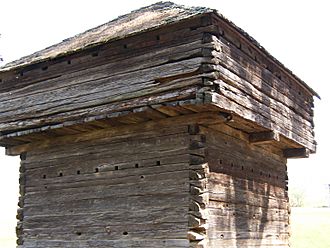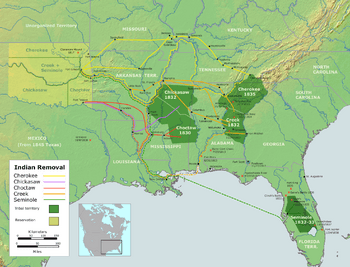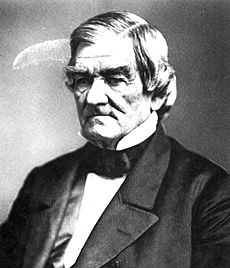Trail of Tears facts for kids

|
|
| Date | Began May 26, 1838 |
|---|---|
| Location | From Georgia to Oklahoma |
| Cause | Indian Removal Act, U.S. expansion, racism |
| Participants | 15,000 Cherokee; 7,000 U.S. soldiers |
| Outcome | Forced removal of the Cherokee from their land |
| Casualties | |
| 353 Cherokee in holding camps | |
| 4,000 Cherokee on the Trail | |
The Trail of Tears was a very sad time in American history. Between 1836 and 1839, the United States government made many Native American people leave their homes. They were forced to move far away from their lands. The U.S. then took over these lands for new settlers, mostly white people.
Thousands of Native Americans died during this forced journey. This is why it is called the "Trail of Tears."
Contents
Why the Trail of Tears Happened
In 1828, gold was discovered near Dahlonega in Georgia. This discovery caused a "gold rush," where many people rushed to the area hoping to find gold. At that time, a Native American group called the Cherokee lived on this land in Georgia. The Cherokee people were very modern for their time. Many of their children went to American schools. They even had their own newspaper and built large houses. Some Cherokee families also owned slaves.
Even though the land belonged to the Cherokee Nation, President Andrew Jackson wanted it for the United States. The land was worth a lot of money, over $7,000,000. President Jackson signed a law called the Indian Removal Act. This law tried to force the Cherokees to move. However, the Cherokees had their own nation and government. They believed they did not have to follow U.S. laws. So, Jackson signed other laws that took away almost all of the Cherokees' rights.
The Cherokee Nation did not want to accept these laws. Their Chief, John Ross, tried to protect the Cherokee rights in U.S. courts. In 1832, the Supreme Court of the United States agreed with the Cherokee. The Court said the Cherokee were living in their own country, and Georgia's laws had "no force" there. This meant Georgia had no right to make the Cherokee do anything.
But the U.S. government still used a treaty to remove the Cherokee. This treaty was called the Treaty of New Echota. It was signed by a small group of Cherokee leaders who did not represent the whole Nation. Because an official Cherokee leader did not sign it, the treaty was not legal under Cherokee law. About 15,000 Cherokees signed a petition against the treaty. Many newspapers and people across the United States, including John Quincy Adams, also protested it. Still, the United States Senate approved the treaty by only one vote. President Jackson signed the treaty into law on May 23, 1836. The treaty gave the Cherokees two years to leave their lands. Only about 2,000 people left on their own.
The Forced Journey Begins
"I fought through the War Between the States and have seen many men shot, but the Cherokee Removal was the cruelest work I ever knew."
- A Georgia soldier who helped with the removal
The deadline for the Cherokees to leave their land was May 23, 1838. President Martin Van Buren sent General Winfield Scott to lead the soldiers. These soldiers would force the Cherokee to move.
On May 26th, the forced removal officially began. 7,000 soldiers made about 15,000 Cherokees and 2,000 of their slaves leave their homes right away. Within three weeks, all Cherokees were forced into special camps. They had to stay in these camps during the summer of 1838. Sadly, 353 Cherokee people died in these camps from diseases like dysentery.
Finally, Chief Ross made a deal with General Scott. Chief Ross promised that he and other Cherokee leaders would guide their people to their new lands themselves. General Scott agreed and even got the U.S. Army to pay for the trip.
The Cherokee traveled in groups of 1,000 to 3,000 people. They used three main routes. Different groups started in Chattanooga, Tennessee; Guntersville, Alabama; and Charleston, Tennessee. Most Cherokees had to walk. Some wealthy men could use wagons. The U.S. government also gave the Cherokee about 660 wagons.
It is said that many Cherokees sang a Cherokee version of the song Amazing Grace. This song became a special anthem for the Cherokee Nation.
The trip was about 1,200 miles long. During the journey, the Cherokee faced harsh winter weather, blizzards, and diseases. People do not agree on the exact number of deaths. Some say 2,000, others say 6,000, but most believe about 4,000 people died. Finally, the Cherokee who survived arrived in what is now Oklahoma.
The Different Paths They Took
The Cherokee took different paths to their new lands. Some traveled by water, and others by land. Traveling by water could be dangerous because some boats were destroyed. On land, people had to walk through mud and cold weather, which was very hard.
Water Routes
About 2,800 Cherokees traveled by water in three groups. All groups started at Ross's Landing on the Tennessee River. They used boats to travel to the Ohio River, then south to the Mississippi River. From the Mississippi, they took the Arkansas River westward. They arrived near Fort Coffee, Oklahoma. The first group left on June 6 and reached the new territory in 13 days. The second and third groups had many problems with diseases, so their trips took longer.
Land Routes
Most people traveled by land. Leaders chosen by John Ross guided groups of 700 to 1,600 people, usually on northern routes. These paths went through central Tennessee, southwestern Kentucky, and southern Illinois. The groups crossed the Mississippi River north of Cape Girardeau, Missouri. Then they traveled through southern Missouri and west of Arkansas. The Cherokee who signed the Treaty of New Echota were willing to trade their homeland for $5 million and land in Oklahoma. United States soldiers led them, usually taking a southern route. All land routes usually ended near Westville, Oklahoma. These routes covered more than 2,200 miles across 9 states. Many people died on the journey because of diseases, not enough water, and bad road conditions.
Cool Facts About the Trail of Tears

- The five tribes most affected by the Indian Removal Act were called the Five Civilized Tribes. They had tried to adopt some American customs and were friendly with the colonists.
- Even though they were given money for food, many Cherokee died of starvation. This happened because dishonest merchants sold them bad food at very high prices.
- The Trail of Tears was not the end of the mistreatment of Native Americans. Much of their new land in Oklahoma was later taken from them too.
- The Cherokee who survived the Trail of Tears built a new nation and government in Tahlequah, Oklahoma.
- John Ross survived the Trail of Tears. He was elected Principal Chief of the new Cherokee Nation in 1839.
- Some of the Cherokee men who survived the Trail of Tears later killed John Ridge. He was a Cherokee leader who agreed to the Treaty of New Echota.
- The U.S. government did not pay the Cherokee the $5 million they were owed from the Treaty of New Echota until the Cherokee filed petitions.
- The Seminole tribe, one of the tribes forced to move, fought against it for seven years.
- Because of the Indian Removal Act, 25 million acres of land in the southeastern United States became available for settlers and colonists.
Related Pages
- Native Americans in the United States
- Manifest Destiny (the idea that the U.S. had the right to take the lands they wanted)
- Forced migration
Images for kids
-
George W. Harkins, a Choctaw chief
-
Alexis de Tocqueville, a French political thinker and historian
-
Seminole warrior Tuko-see-mathla, 1834
-
Selocta (or Shelocta) was a Muscogee chief who asked Andrew Jackson to reduce the demands for Creek lands at the signing of the Treaty of Fort Jackson.
-
Historic Marker in Marion, Arkansas, for the Trail of Tears
-
Elizabeth "Betsy" Brown Stephens (1903), a Cherokee Indian who walked the Trail of Tears in 1838
See also
 In Spanish: Sendero de lágrimas para niños
In Spanish: Sendero de lágrimas para niños










